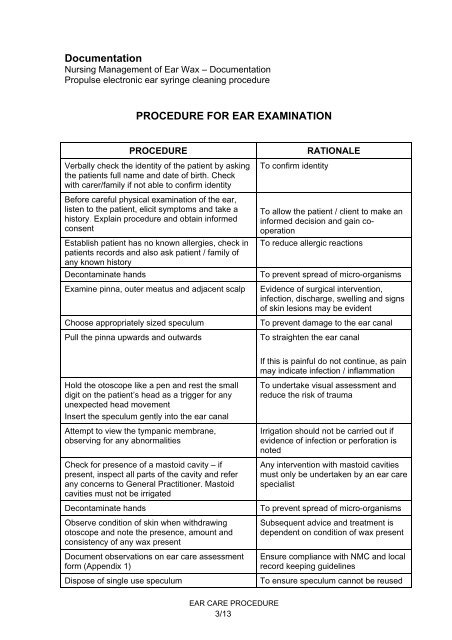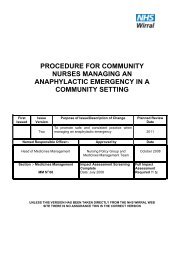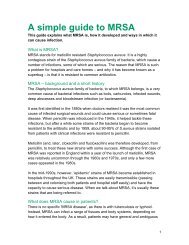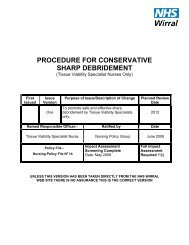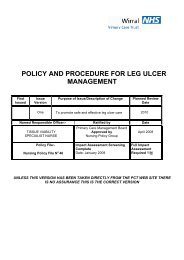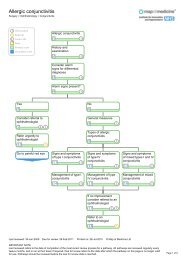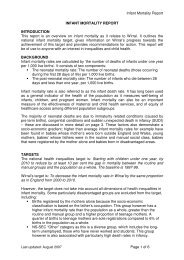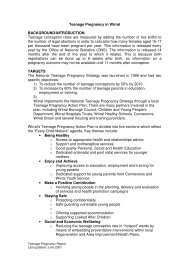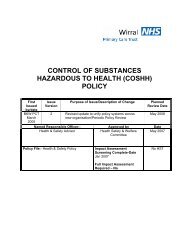EAR CARE PROCEDURE FOR COMMUNITY NURSING SERVICES
EAR CARE PROCEDURE FOR COMMUNITY NURSING SERVICES
EAR CARE PROCEDURE FOR COMMUNITY NURSING SERVICES
You also want an ePaper? Increase the reach of your titles
YUMPU automatically turns print PDFs into web optimized ePapers that Google loves.
Documentation<br />
Nursing Management of Ear Wax – Documentation<br />
Propulse electronic ear syringe cleaning procedure<br />
<strong>PROCEDURE</strong> <strong>FOR</strong> <strong>EAR</strong> EXAMINATION<br />
<strong>PROCEDURE</strong><br />
Verbally check the identity of the patient by asking<br />
the patients full name and date of birth. Check<br />
with carer/family if not able to confirm identity<br />
Before careful physical examination of the ear,<br />
listen to the patient, elicit symptoms and take a<br />
history. Explain procedure and obtain informed<br />
consent<br />
Establish patient has no known allergies, check in<br />
patients records and also ask patient / family of<br />
any known history<br />
Decontaminate hands<br />
Examine pinna, outer meatus and adjacent scalp<br />
Choose appropriately sized speculum<br />
Pull the pinna upwards and outwards<br />
To confirm identity<br />
RATIONALE<br />
To allow the patient / client to make an<br />
informed decision and gain cooperation<br />
To reduce allergic reactions<br />
To prevent spread of micro-organisms<br />
Evidence of surgical intervention,<br />
infection, discharge, swelling and signs<br />
of skin lesions may be evident<br />
To prevent damage to the ear canal<br />
To straighten the ear canal<br />
If this is painful do not continue, as pain<br />
may indicate infection / inflammation<br />
Hold the otoscope like a pen and rest the small<br />
digit on the patient’s head as a trigger for any<br />
unexpected head movement<br />
Insert the speculum gently into the ear canal<br />
Attempt to view the tympanic membrane,<br />
observing for any abnormalities<br />
Check for presence of a mastoid cavity – if<br />
present, inspect all parts of the cavity and refer<br />
any concerns to General Practitioner. Mastoid<br />
cavities must not be irrigated<br />
Decontaminate hands<br />
Observe condition of skin when withdrawing<br />
otoscope and note the presence, amount and<br />
consistency of any wax present<br />
Document observations on ear care assessment<br />
form (Appendix 1)<br />
Dispose of single use speculum<br />
To undertake visual assessment and<br />
reduce the risk of trauma<br />
Irrigation should not be carried out if<br />
evidence of infection or perforation is<br />
noted<br />
Any intervention with mastoid cavities<br />
must only be undertaken by an ear care<br />
specialist<br />
To prevent spread of micro-organisms<br />
Subsequent advice and treatment is<br />
dependent on condition of wax present<br />
Ensure compliance with NMC and local<br />
record keeping guidelines<br />
To ensure speculum cannot be reused<br />
<strong>EAR</strong> <strong>CARE</strong> <strong>PROCEDURE</strong><br />
3/13


